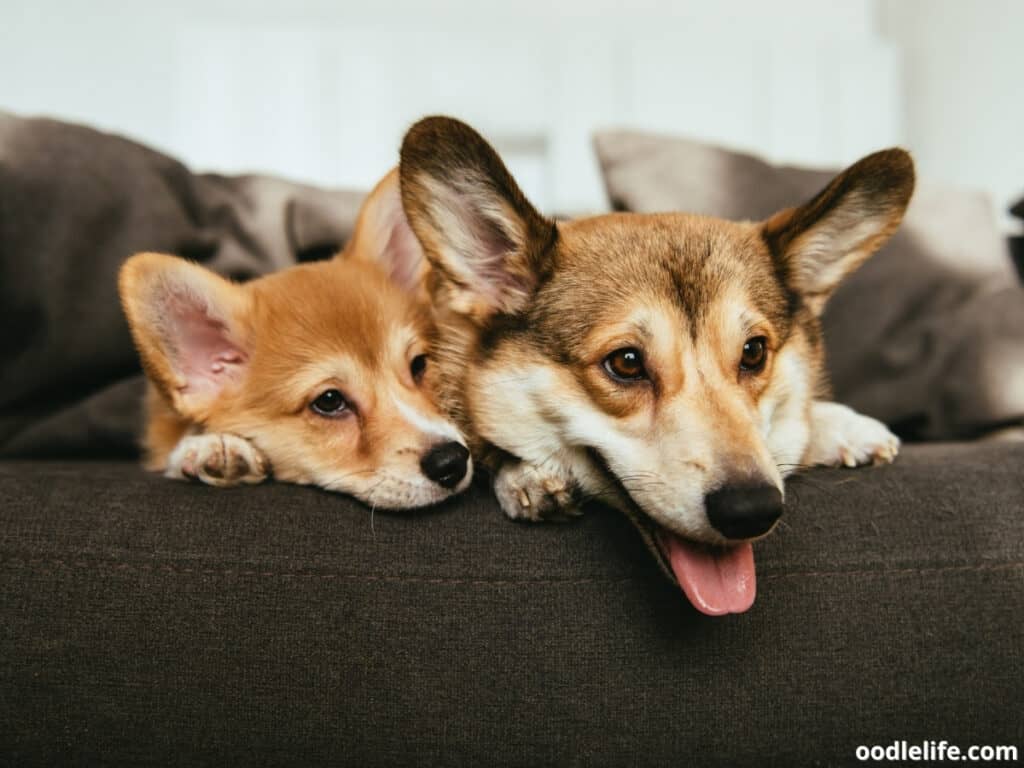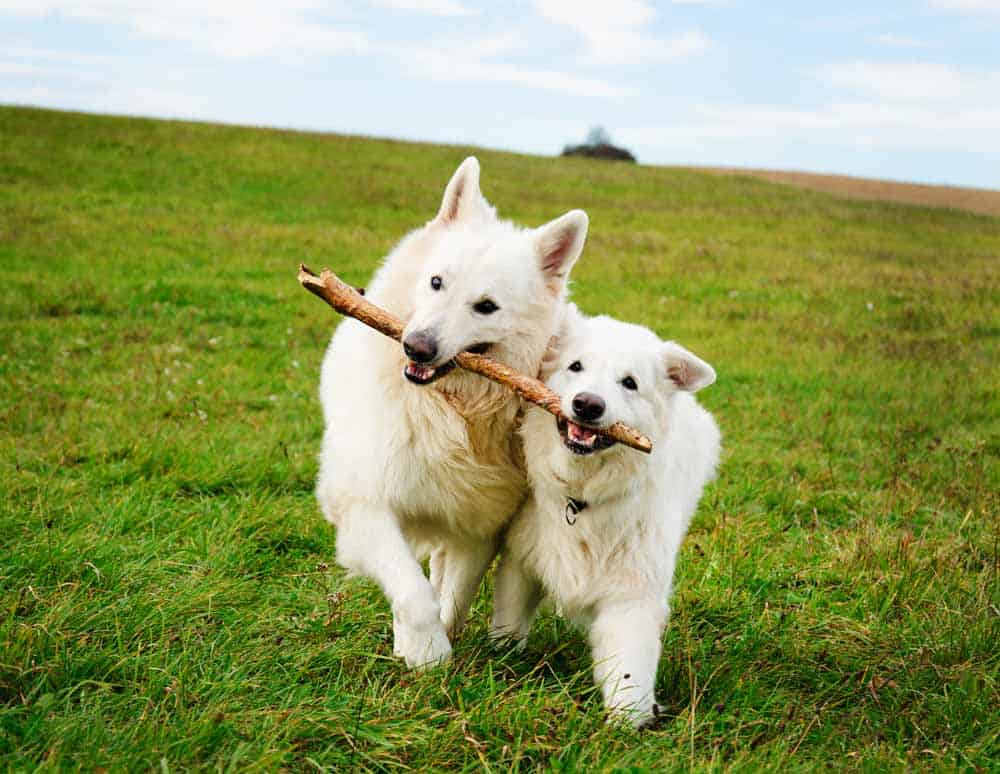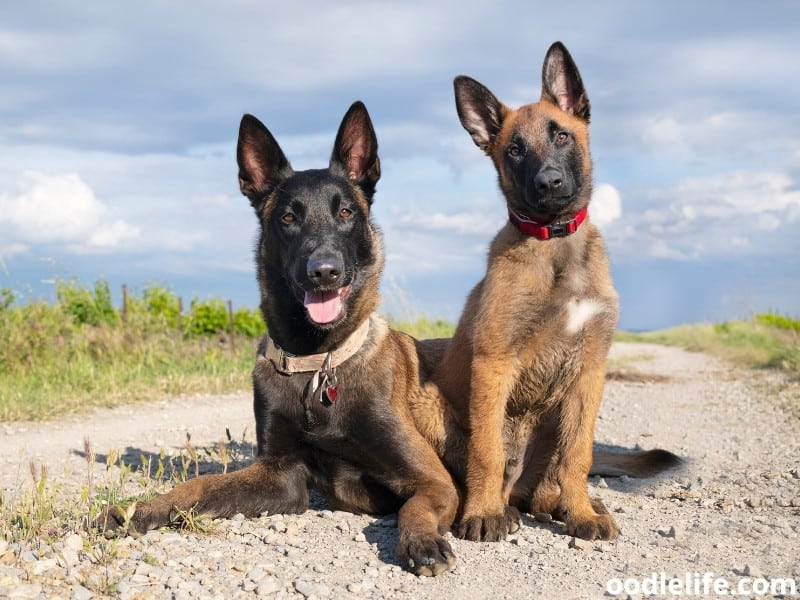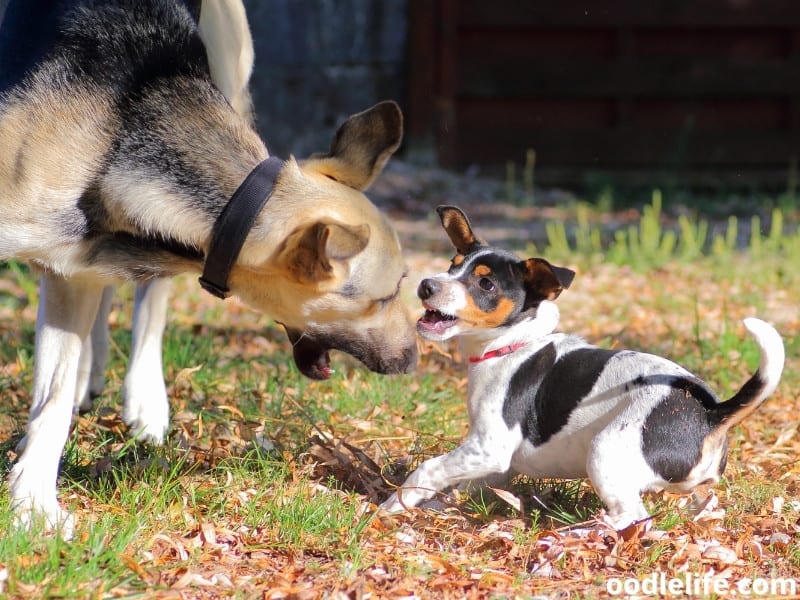How To Introduce Two Dogs? – Step By Step Guide
Introducing two dogs can be a daunting task, but if done correctly, it can be a very rewarding experience for both dogs and their owners. It would be helpful if you had a friend or family member help, as you’ll want to introduce your two dogs out of your home and on neutral ground.

First and foremost, make sure that both dogs are healthy and have been properly vaccinated. Your new puppy should be fully vaccinated at 12 weeks old, and your resident dog should be kept up to date on shots like distemper, parvo, and rabies.
Choose a neutral location, such as a park or a quiet street. Walk your resident dog and have a friend walk your new puppy.
You’ll want to let the dogs sniff each other. This is how they’ll get to know each other’s scent.
Go on pack walks together, slowly extending the duration. Don’t force things. If you see your resident dog go stiff and tense, separate them, and try again when everyone is more relaxed.

Once your dogs seem comfortable with each other, you can slowly try to head home. Keep in mind that your resident dog will see your home as HIS or HER territory. Look out for aggressive or territorial behavior like growling or snapping.
Keep all existing toys and food out of reach for now so that there is less chance of confrontation. Keep both dogs on a leash, especially your older, bigger resident dog.
If the resident is feeling threatened or exceedingly growly, you might want to put your puppy in a separate room and out of reach until things calm down again.
If your resident dog takes a snap at the pup, deliver a firm correction and then separate the two. Don’t punish your dogs or resentment might build.
Take things slow and at the first sign of trouble, separate them. Your older dog isn’t likely to severely hurt the puppy.
The majority of the time, the snaps and growls are meant to put the pup in place and teach him boundaries. However, keep a watch on them at all times and never allow unsupervised interactions until you are sure of your resident dog’s comfort level.
Introducing two dogs takes time and a whoooooole lotta patience. Don’t be concerned if things don’t work out immediately, especially if your dog is known to be an ol’ grump.
Simply have them separated for the time being and keep an eye on them every time they are together. In addition, here are some extra tips to help your dogs get along.
1. Start slowly and build up the time spent together gradually.
2. Keep them separate when you’re not around to supervise.
3. Let them approach each other on their own terms.
4. Encourage positive interactions with treats and toys. Always treat your older dog first.
5. Break up any negative experiences immediately and separate them for a few hours until things calm down.
6. Be consistent with the rules you set.
8. Never force them to interact if they don’t want to.
9. Avoid any situations that could lead to conflict. You might want to feed them in opposite corners of your home for now and remove any toys that could be a problem.
10. Be patient and give them time to adjust to each other. Just like humans, we all can’t instantly be best friends!

Why Is My Dog Being Mean To My New Puppy?
It’s tough enough to be the new kid on the block, but when you’re the new puppy trying to join a pack that already exists, it can be downright scary. If your older dog is giving your new puppy a hard time, there are a few things you can do to help them get along.
First and foremost, make sure that your older dog is getting enough attention. It’s only natural for them to feel a little left out now that there’s a new pup in the house.
Be sure to give them plenty of quality time, including some one-on-one playtime and belly rubs. They need to know that they’re still an important part of the family.
It’s also important to give your new puppy their own space. Just because they’re small doesn’t mean they don’t need their own place to retreat to when they want some peace and quiet.
Set up a crate or dog bed in a quiet corner of the house where they can go to get away from it all. This will also help them feel more secure in their new surroundings.
Finally, keep an eye on how much food you’re giving each dog. Older dogs can sometimes be greedy when it comes to food, so it’s important to make sure your new puppy is getting enough to eat. They need plenty of energy to grow and play, so be sure they’re getting the proper nutrition.
It’s not always easy being the new kid on the block, but with a little patience and understanding, you can help your old dog and new puppy get along just fine.
Give them each some attention and their own space, and make sure everyone is getting enough to eat, and you’ll have a happy, well-adjusted pack in no time!

How Do I Get My Older Dog to Stop Attacking My New Puppy?
As seen, older dogs may have several reasons for attacking your new puppy. How to tackle this issue may vary based on a variety of factors. Of course, being that dogs are animals, there are never guarantees on how things will work out. There are however several management options and training options new puppy owners can rely on, so here are some general tips to ameliorate the situation.
Puppy Care : How to Stop An Older Dog From Being Aggressive to A Puppy
Joanna B. wrote that her daughter’s 10-month-old Labrador Retriever loves to get in the face of her adult Coton de Tulear, which responds by growling and snapping. The result is that the Lab puppy tries even harder to get close to the Coton.
It’s very common for families to bring home a new puppy when there is an older dog in the home. Here are some tips to help make a smooth introduction between dogs.
It is 100 percent normal for your adult dog(s) not to love a puppy. It’s OK for your adult dog not to want to be jumped on or be a chew toy for a new puppy. Dogs aren’t programmed to take care of youngsters. Your dog may want to go away from the puppy or may growl or even snap to tell the puppy to go away. However, if your older dog uses his teeth on the new puppy, that is not normal, and it may be time to consult with a veterinary behaviorist.
Puppies do not have the canine communication skills of an adult dog. They don’t know how to be polite. Over time, the dogs and other puppies your new puppy interacts with will teach him proper canine manners. For now, your puppy is still learning, and his behavior can seem very rude to an adult dog.
Help give your adult dog a break from a goofy puppy. Having your dog crate trained is an excellent choice for many reasons and is helpful when bringing home a new puppy. If your puppy is bothering your dog, you can call the older dog and send him to his crate with a delicious chew toy. This rewards your dog for staying calm and shows him that you are there to keep him safe. You can also give your puppy time-outs in his crate. Giving each dog time to be on his own is important because it gives the older dog a break and helps teach the puppy to relax when alone.
Never leave high-value objects, such as bones or your dog’s favorite toys, on the floor with the dog and puppy. The puppy’s instinct to explore them may upset the adult dog and trigger resource guarding. Instead, keep these items picked up and only give out special treats when you can give one to each dog and be there to supervise.
Never leave your new puppy alone unsupervised with your adult dog. It’s much safer to place one or both dogs in a crate with a chew toy when you leave the house. It can take a few months for your adult dog and puppy to fully acclimate to each other. 
Don’t punish your dog for growling at the puppy. Growling is normal dog communication, and he is letting the puppy (and you) know he’s had enough. Instead of punishing this important communication, calmly separate them.
Make sure you continue to give your adult dog personal time with you. Maintaining the bond between you and your adult dog is just as important as building a bond with the new puppy. Your adult dog should continue receiving one-on-one play and training sessions. Using positive reinforcement with your adult dog while the puppy is around will also help your dog build a better association with the newcomer.
It takes time for dogs to get to know one another and make friends. Be patient as your adult dog learns to cope with a new puppy. Also, be patient as your new puppy learns the rules of your home and how to behave toward your current dog. Practice management, supervision, and positive reinforcement to help everyone learn to get along peacefully. Never hesitate to speak to your veterinarian or a dog trainer if you have any concerns about your dog getting along with your new puppy.
Our dogs are cherished members of our families, sharing our lives and providing unconditional love. But all dog owners know that our canine partners have different perspectives on life than our human family members.
If you have ever asked, “Why does my dog do that?” then this feature is for you. The AKC GoodDog! Helpline training team will answer your questions on dogs’ behavior and offer training advice to help you and your dog have the best relationship possible. The AKC GoodDog! Helpline is a seven-day-a-week telephone support service staffed by professional dog trainers. For more information on the service and how to enroll go to www.akcgooddoghelpline.org. https://www.akc.org/wp-admin/admin-ajax.php Get Your Free AKC eBook
AKC is a participant in affiliate advertising programs designed to provide a means for sites to earn advertising fees by advertising and linking to akc.org. If you purchase a product through this article, we may receive a portion of the sale.